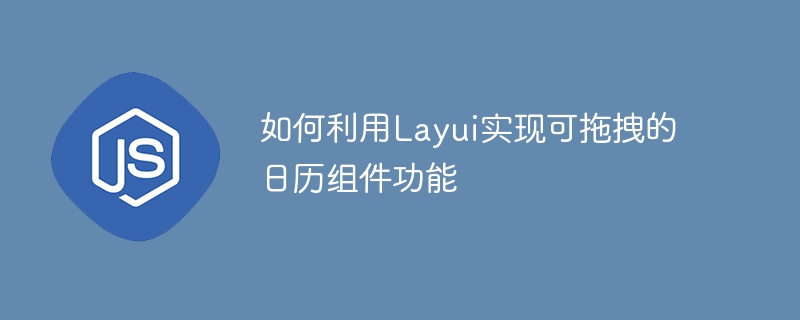Home >Web Front-end >JS Tutorial >How to use Layui to implement drag-and-drop calendar component functions
How to use Layui to implement drag-and-drop calendar component functions
- PHPzOriginal
- 2023-10-26 12:12:22987browse

How to use Layui to implement drag-and-drop calendar component functions
1. Introduction
Layui is a lightweight web front-end framework that provides a wealth of UI components and simple and easy-to-use API interface. In daily development, we often need to use calendar components to display and manage time information. This article will introduce how to use Layui's drag and drop function to implement a draggable calendar component.
2. Preparation work
Before we start, we need to do some preparation work.
- Download Layui Framework
First, we need to download the Layui framework. You can download the latest Layui version from the Layui official website (https://www.layui.com/). - Introduce Layui components
Extract the downloaded Layui file and introduce the corresponding Layui component file into the HTML file. For specific introduction methods, please refer to Layui official documentation.
3. Implement a draggable calendar component
- HTML code
In the HTML file, we need to create a calendar container. You can use a div element as a container and set a unique ID for subsequent operations.
- CSS style
In order to achieve the draggable effect , we need to set the corresponding CSS style for the calendar container. You can use the following styles as a reference:
.calendar {
width: 600px;
height: 600px;
border: 1px solid #ccc;
overflow: auto;
}
- JavaScript code
Next, we need to use Layui’s drag and drop component to implement the calendar’s drag and drop function.
First, introduce the Layui component into the JavaScript code:
Then, initialize the Layui component:
<script><br>layui.use(['element', 'laydate', 'layer', 'table', 'form', 'jquery'], function () {<br> var element = layui.element;<br> var laydate = layui.laydate;<br> var layer = layui.layer;<br> var table = layui.table;<br> var form = layui .form;<br> var $ = layui.$;</script>
//Initialize calendar drag function
calendarDrag();
});
function calendarDrag() {
var calendarElem = document.getElementById('calendar');
var dragElem = calendarElem.firstChild;
dragElem.onmousedown = function(event) {
// 获取鼠标按下时的位置
var startX = event.clientX;
var startY = event.clientY;
// 获取日历容器的初始位置
var calendarX = calendarElem.offsetLeft;
var calendarY = calendarElem.offsetTop;
document.onmousemove = function(event) {
// 计算鼠标移动的距离
var moveX = event.clientX - startX;
var moveY = event.clientY - startY;
// 更新日历容器的位置
calendarElem.style.left = calendarX + moveX + 'px';
calendarElem.style.top = calendarY + moveY + 'px';
};};
document.onmouseup = function() {
document.onmousemove = null;
};
}
4. Effect Demonstration
After the above steps With the operation, we have successfully implemented a draggable calendar component. Open the HTML file in the browser and drag the calendar container to achieve the moving effect.
Summary
This article introduces how to use Layui to implement a drag-and-drop calendar component. By using Layui's drag and drop component, combined with relevant HTML, CSS and JavaScript code, we can easily implement a calendar component with drag and drop functionality. I hope this article will be helpful to your study and work.
The above is the detailed content of How to use Layui to implement drag-and-drop calendar component functions. For more information, please follow other related articles on the PHP Chinese website!

